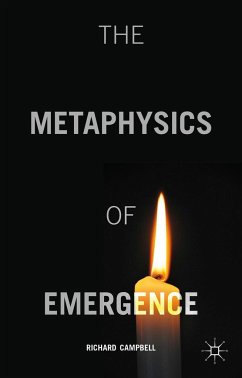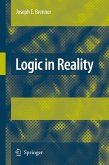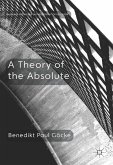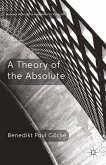R. Campbell
The Metaphysics of Emergence
R. Campbell
The Metaphysics of Emergence
- Gebundenes Buch
- Merkliste
- Auf die Merkliste
- Bewerten Bewerten
- Teilen
- Produkt teilen
- Produkterinnerung
- Produkterinnerung
This book argues that a plausible account of emergence requires replacing the traditional assumption that what primarily exists are particular entities with generic processes. Traversing contemporary physics and issues of identity over time, it then proceeds to develop a metaphysical taxonomy of emergent entities and of the character of human life.
Andere Kunden interessierten sich auch für
![The Metaphysics of Emergence The Metaphysics of Emergence]() R. CampbellThe Metaphysics of Emergence38,99 €
R. CampbellThe Metaphysics of Emergence38,99 €![Logic in Reality Logic in Reality]() JOSEPH BRENNERLogic in Reality200,99 €
JOSEPH BRENNERLogic in Reality200,99 €![A Theory of the Absolute A Theory of the Absolute]() B. GöckeA Theory of the Absolute46,54 €
B. GöckeA Theory of the Absolute46,54 €![A Theory of the Absolute A Theory of the Absolute]() B. GöckeA Theory of the Absolute38,99 €
B. GöckeA Theory of the Absolute38,99 €![German Idealism and the Problem of Knowledge: German Idealism and the Problem of Knowledge:]() Nectarios G LimnatisGerman Idealism and the Problem of Knowledge:112,99 €
Nectarios G LimnatisGerman Idealism and the Problem of Knowledge:112,99 €![The Cost of Free Speech The Cost of Free Speech]() A. LevinThe Cost of Free Speech38,99 €
A. LevinThe Cost of Free Speech38,99 €![Aiming at Truth Aiming at Truth]() N. UnwinAiming at Truth38,99 €
N. UnwinAiming at Truth38,99 €-
-
-
This book argues that a plausible account of emergence requires replacing the traditional assumption that what primarily exists are particular entities with generic processes. Traversing contemporary physics and issues of identity over time, it then proceeds to develop a metaphysical taxonomy of emergent entities and of the character of human life.
Produktdetails
- Produktdetails
- Verlag: Palgrave Macmillan / Palgrave Macmillan UK / Springer Palgrave Macmillan
- Artikelnr. des Verlages: 978-1-137-50237-7
- 2015 edition
- Seitenzahl: 333
- Erscheinungstermin: 24. April 2015
- Englisch
- Abmessung: 223mm x 141mm x 25mm
- Gewicht: 546g
- ISBN-13: 9781137502377
- ISBN-10: 1137502371
- Artikelnr.: 42286013
- Herstellerkennzeichnung
- Libri GmbH
- Europaallee 1
- 36244 Bad Hersfeld
- gpsr@libri.de
- Verlag: Palgrave Macmillan / Palgrave Macmillan UK / Springer Palgrave Macmillan
- Artikelnr. des Verlages: 978-1-137-50237-7
- 2015 edition
- Seitenzahl: 333
- Erscheinungstermin: 24. April 2015
- Englisch
- Abmessung: 223mm x 141mm x 25mm
- Gewicht: 546g
- ISBN-13: 9781137502377
- ISBN-10: 1137502371
- Artikelnr.: 42286013
- Herstellerkennzeichnung
- Libri GmbH
- Europaallee 1
- 36244 Bad Hersfeld
- gpsr@libri.de
Richard Campbell AM is Emeritus Professor of Philosophy at The Australian National University. He has served as Dean of Arts and Pro-Vice-Chancellor at the ANU, and was for 15 years also involved in restructuring the system of school education in the Australian Capital Territory. In 1986 he was installed by Queen Elizabeth II as a Member of the Order of Australia. He is author of Secondary Education for Canberra (1973), From Belief to Understanding (1976), Truth and Historicity (1992), The Concept of Truth (2011), and numerous articles.
PART I: PROCESSES AND ENTITIES 1.1 Change and Stability 1.2 The Need for a New Metaphysics 1.3 An Overview of the Project 1.4 A Terminological Difficulty PART II: THE METAPHYSICS OF PARTICULAR ENTITIES 2.1 The Reification of Being and the Unreality of Change 2.2 The Invention of the Timeless 2.3 Entity as the Primary Category 2.4 Entities as Countable Particulars 2.5 The Invention of Material 2.6 Explaining Change 2.7 The Disintegration of the Aristotelian Explanatory Model 2.8 Descartes' Metaphysical Dichotomy 2.9 Locke, Newton and the 'Corpuscular Philosophy' 2.10 The Rise of Physicalist Metaphysics PART III: CONCEPTUAL SHIFTS IN PHYSICS 3.1 The Invention of Physical Science 3.2 The Fate of 'Matter' 3.3 The Superseding of Newtonian Physics 3.4 Reconceptualizing 'Particles' 3.5 'Particles' and Quantum Fields 3.6 Conceptualizing Quantum Phenomena 3.7 Realist Interpretations of QFT 3.8 Metaphysical Implications PART IV: THE CATEGORY OF GENERIC PROCESSES 4.1 Processes, Stuffs, and Particulars 4.2 Generic and Specific Processes 4.3 Identifying Categories 4.4 The Logic of Process-descriptions 4.5 Processes, Entities, and their Parts 4.6 Re-categorizing Countables 4.7 The 'Part-of' Relation 4.8 Processes and Series of Events 4.9 Whitehead's Process Metaphysics PART V: IDENTITY THROUGH CHANGE 5.1 Identity and Discernible Difference 5.2 Identity as Continuity of Temporal Parts 5.3 Change in Four-dimensional Entities 5.4 Common Assumptions 5.5 Heraclitus' Insight 5.6 Change in Enduring Entities 5.7 Sameness across Different Times 5.8 The Types of Generic Process PART VI: A METAPHYSICAL TAXONOMY OF EMERGENT ENTITIES 6.1 Processes and their Organizations 6.2 Persistence and Stability 6.3 Entities as Cohesive Organizations of Processes 6.4 Energy-wells 6.5 Far-from-Equilibrium Stability 6.6 Self-maintenant Systems 6.7 Recursively Self-maintenant Systems 6.8 The Status of the Concept of Recursive Self-maintenance PART VII: AN EVOLUTIONARY TAXONOMY OF TYPES OF ACTION AND LIFE 7.1 Agency and Causation 7.2 Goal-Directedness 7.3 Serving a Function 7.4 Liability to Error 7.5 Minimal Action 7.6 Selective Action 7.7 Error Detection 7.8 Flexible Learners 7.9 Self-reflective Persons interacting with Externalized Knowledge 7.10 Social Institutions and Groups 7.11 Conclusion PART VIII: THE CONCEPT OF EMERGENCE 8.1 Clarifying the Issues 8.2 'Emergence Bases' and Open Systems 8.3 A Definition of Emergence 8.4 Emergence and Non-linearity 8.5 Self-organization 8.6 Emergence and Reduction 8.7 Emergence and the Causal Exclusion Argument 8.8 Downward Causation and Physical Laws PART IX: THE WORLD ACCORDING TO PHYSICALISM 9.1 Defining Physicalism in terms of 'Physical Objects' 9.2 Defining Physicalism in terms of Physical Theory 9.3 Mereological Supervenience 9.4 The Irreducibility of Actions 9.5 Non-reductive Supervenience 9.6 Humean Supervenience 9.7 Global Supervenience 9.8 Basic Particulars 9.9 Physicalism without Particulars? PART X: THE MENTAL ACTIVITY OF HUMAN BEINGS 10.1 Intentionality and Mental Content 10.2 Correspondence Accounts of Representations 10.3 The Interactive Model of Representations 10.4 The Emergence of Awareness 10.5 The 'Hard Problem' of Consciousness 10.6 Sensory Experience 10.7 The Emergence of Reflective Consciousness 10.8 Rationality 10.9 Being Conscious of Oneself PART XI: FURTHER REFLECTIONS 11.1 Time 11.2 The Puzzle about Entropy 11.3 The Emergence of Values 11.4 Freedom and Causation 11.5 Concluding Reflections
PART I: PROCESSES AND ENTITIES 1.1 Change and Stability 1.2 The Need for a New Metaphysics 1.3 An Overview of the Project 1.4 A Terminological Difficulty PART II: THE METAPHYSICS OF PARTICULAR ENTITIES 2.1 The Reification of Being and the Unreality of Change 2.2 The Invention of the Timeless 2.3 Entity as the Primary Category 2.4 Entities as Countable Particulars 2.5 The Invention of Material 2.6 Explaining Change 2.7 The Disintegration of the Aristotelian Explanatory Model 2.8 Descartes' Metaphysical Dichotomy 2.9 Locke, Newton and the 'Corpuscular Philosophy' 2.10 The Rise of Physicalist Metaphysics PART III: CONCEPTUAL SHIFTS IN PHYSICS 3.1 The Invention of Physical Science 3.2 The Fate of 'Matter' 3.3 The Superseding of Newtonian Physics 3.4 Reconceptualizing 'Particles' 3.5 'Particles' and Quantum Fields 3.6 Conceptualizing Quantum Phenomena 3.7 Realist Interpretations of QFT 3.8 Metaphysical Implications PART IV: THE CATEGORY OF GENERIC PROCESSES 4.1 Processes, Stuffs, and Particulars 4.2 Generic and Specific Processes 4.3 Identifying Categories 4.4 The Logic of Process-descriptions 4.5 Processes, Entities, and their Parts 4.6 Re-categorizing Countables 4.7 The 'Part-of' Relation 4.8 Processes and Series of Events 4.9 Whitehead's Process Metaphysics PART V: IDENTITY THROUGH CHANGE 5.1 Identity and Discernible Difference 5.2 Identity as Continuity of Temporal Parts 5.3 Change in Four-dimensional Entities 5.4 Common Assumptions 5.5 Heraclitus' Insight 5.6 Change in Enduring Entities 5.7 Sameness across Different Times 5.8 The Types of Generic Process PART VI: A METAPHYSICAL TAXONOMY OF EMERGENT ENTITIES 6.1 Processes and their Organizations 6.2 Persistence and Stability 6.3 Entities as Cohesive Organizations of Processes 6.4 Energy-wells 6.5 Far-from-Equilibrium Stability 6.6 Self-maintenant Systems 6.7 Recursively Self-maintenant Systems 6.8 The Status of the Concept of Recursive Self-maintenance PART VII: AN EVOLUTIONARY TAXONOMY OF TYPES OF ACTION AND LIFE 7.1 Agency and Causation 7.2 Goal-Directedness 7.3 Serving a Function 7.4 Liability to Error 7.5 Minimal Action 7.6 Selective Action 7.7 Error Detection 7.8 Flexible Learners 7.9 Self-reflective Persons interacting with Externalized Knowledge 7.10 Social Institutions and Groups 7.11 Conclusion PART VIII: THE CONCEPT OF EMERGENCE 8.1 Clarifying the Issues 8.2 'Emergence Bases' and Open Systems 8.3 A Definition of Emergence 8.4 Emergence and Non-linearity 8.5 Self-organization 8.6 Emergence and Reduction 8.7 Emergence and the Causal Exclusion Argument 8.8 Downward Causation and Physical Laws PART IX: THE WORLD ACCORDING TO PHYSICALISM 9.1 Defining Physicalism in terms of 'Physical Objects' 9.2 Defining Physicalism in terms of Physical Theory 9.3 Mereological Supervenience 9.4 The Irreducibility of Actions 9.5 Non-reductive Supervenience 9.6 Humean Supervenience 9.7 Global Supervenience 9.8 Basic Particulars 9.9 Physicalism without Particulars? PART X: THE MENTAL ACTIVITY OF HUMAN BEINGS 10.1 Intentionality and Mental Content 10.2 Correspondence Accounts of Representations 10.3 The Interactive Model of Representations 10.4 The Emergence of Awareness 10.5 The 'Hard Problem' of Consciousness 10.6 Sensory Experience 10.7 The Emergence of Reflective Consciousness 10.8 Rationality 10.9 Being Conscious of Oneself PART XI: FURTHER REFLECTIONS 11.1 Time 11.2 The Puzzle about Entropy 11.3 The Emergence of Values 11.4 Freedom and Causation 11.5 Concluding Reflections








